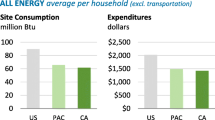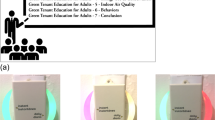Abstract
The Colorado College Energy Audit and Retrofit Program is a non-profit organization that teaches students the science and mechanics involved in energy audits and retrofit work through service–learning and community-based research projects. This approach represents a “win–win” scenario where the college contributes to maximize learning and minimize costs to the community. The method of identifying homes for energy audits has evolved from responding to homeowner requests to a proactive approach aimed at targeting older low-income neighborhoods and working with existing neighborhood associations. Recent work on the Mill Street Neighborhood in Colorado Springs, Colorado is presented in which a sample of homes (N = 14) received thermal audits, complete with blower door tests and Energy-10 computer modeling. The results are tabulated, analyzed, and extrapolated over the entire 145 homes in the neighborhood. The normally distributed ACH n values and the skewed distributions of R aver values and building sizes are discussed. A method of identifying unusual occupant behavior, relative to the building quality, is presented where the Home Heating Index is compared to a Building Thermal Performance Index (R aver/ACH n ). Estimates from extrapolation of the data predict that an investment of $146,500 USD in retrofit materials will yield a total annual neighborhood savings in energy, utility costs and GHG emissions of 9.1 × 106 kBtu (9.6 × 109 kJ), $64,000 USD and 555 US tons (5.0 × 105 kg), respectively, providing a simple payback time of 2.3 years. This efficient method of neighborhood energy audits provides data that could support neighborhood renewal grant proposals to purchase materials for follow-up retrofits and supports municipal demand-side management programs.






Similar content being viewed by others
References
Brown, M. A., Stovall, T. K., & Hughes, P. J. (2007). Potential carbon emissions reductions in the buildings sector by 2030. In C. Kutscher (Ed.), Tackling climate change in the US: Potential carbon emissions reductions from energy efficiency and renewable energy by 2030 (pp. 51–65). Boulder, CO: American Solar Energy Society.
CEC (2006). Choices for the Home. California Energy Commission: Consumer Energy Center. Available from: www.consumerenergycenter.org/home/heating_cooling/firewood.html. Accessed on Fall 2009.
ColoradoEnergy.org (2008). Available from: www.coloradoenergy.org/procorner/stuff/air_infiltration.htm. Accessed on April 2010.
Colorado Springs (2009). Colorado Springs Average Prices of Homes Based on Zip Code and Size. Available from: www.colorado-springs-realestate.com/average-home-sizes-and-prices.php?aid=hsliv. Accessed on Fall 2009.
DOE (1999). US Department of Energy, Energy Efficiency for Buildings, Directory of Building Energy Software, Washington D.C. (March 1999). Available from: www.eren.doe.gov/buildings/tools_directory/. Accessed in Spring 2010.
E-STAR. (2004). E-STAR rater training manual: Advancing energy efficiency in housing. Denver, CO: E-Star Colorado.
EIA (2003). Square footage measurements and comparisons: Caveat Emptor. Available from: www.eia.doe.gov/emeu/recs/sqft-measure.html. Accessed on Fall 2009.
Fels, M. (1986). PRISM: An introduction. Energy and Buildings, 9, 5–18.
Green Team (2008). City of Colorado Springs–City Green Team. Information on website: www.springsgov.com/Page.aspx?NavID=1052. Meetings with Green Team members took place in Fall 2008.
Insuldad (2009). Home for Insulating Paint Solutions, “Green” Building Products. Available from: www.insuladd.com. Accessed on Fall 2009.
Krarti, M. (2000). Energy audit of building systems. Boca Raton, Florida: CRC Press.
Krigger, J., & Dorsi, C. (2004). Residential energy (4th ed.). Helena, MT: Saturn Resource Management.
Morgenstern, M., Meyer, S., Whitten, B. & Reuer, M. (2008). The energy retrofit of a building: A journey through Bloom’s learning domains. Journal of College Science Teaching, 37(5), 2008, 16–22.
NSD. (2001). Neighborhood services department. City of Colorado Springs, CO: Mill Street Neighborhood Preservation Plan.
Ruggles, T. (2009). Report on the electric thermal storage units installed at the Baca Campus. Report to Hulbert Center and Facilities Management, Hulbert Center for Southwest Studies, Colorado College.
SBIC (2004). Sustainable Buildings Industry Council. Energy-10 software information: www.sbi-council.org/store/e10.php.
Sherman, Max (1986). Infiltration: Just ACH50 divided by 20? Home Energy, July/Aug 1986.
StateMaster. (2009). Colorado Housing Stats. Available from: www.statemaster.com/red/state/CO-colorado.hou-housing&all=1. Accessed on September 2009.
Acknowledgments
AW would like to thank the Otis T. Barnes Trust for summer support to perform research. THR would like to thank the Hulbert Center Endowment for support. All authors would like to thank the residents of the Mill Street neighborhood for allowing their homes to be used for research and providing some great meals for the team.
Author information
Authors and Affiliations
Corresponding author
Appendix A: A list of abbreviations and terms used in this manuscript
Appendix A: A list of abbreviations and terms used in this manuscript
ACH Air Changes per Hour defines the infiltration rate for a building
BTPI Building Thermal Performance Index developed for this study to separate expected building thermal performance from occupant behavioral effects on energy consumption
CC: Colorado College, Colorado Springs, Colorado, USA
CFM Cubic Feet per Minute defines the volume flow rate in English units (1 CFM = 2.83 × 10−2 m3/min).
Cord Fuel wood volume commonly used for energy content and cost (1 cord = 128 ft3 = 3.62 m3)
DSM Demand-Side Management refers to utility programs encouraging end users to be thrifty in the consumption of energy
EIB Energy Index for Buildings shows the total annual energy flux for a building and includes more than just heating energy usage (Btu/ft2/year = 0.00302 kWh/m2/year)
Energy-10 A software tool from the US Dept. of Energy National Renewable Energy Laboratory (Golden, Colorado, USA) that can be used to quickly identify the most cost-effective retrofit measures for small commercial or residential buildings
E-STAR ENERGY STAR is a joint program of the US Environmental Protection Agency and the US Dept. of Energy that focuses on energy efficient products and practices
GHG Green House Gas refers to gasses (such as CO2) that contribute to global climate change by increasing the greenhouse effect
HDD Heating Degree Day using a base temperature of 65°F (18°C) and a 30-year average. HDD data represents mean average daily values below the base temperature (HDD = °F day)
HHI Home Heating Index is a way to compare buildings heated with fossil fuels such as natural gas. The HHI allows for comparison of different size buildings across different climatic regions since it is a heat transfer coefficient of energy per area per HDD (HHI = Btu/ft2/HDD = Btu/ft2∙day∙°F = 0.24 W/m2 K).
n Factor a climate factor developed at Lawrence Berkeley Laboratory for determining accurate infiltration rates from blower door tests. This factor is independent of whether SI or English units are used in the equation for calculating ACHn
R value Resistance to thermal flow through materials (ft2∙h∙°F/Btu = 0.176 m2 K/W)
U factor Conductivity of thermal flow through materials (Btu/ft2∙h∙°F = 5.678 W/m2 K)
USD United States Dollars
Rights and permissions
About this article
Cite this article
Wierzba, A.L., Morgenstern, M.A., Meyer, S.A. et al. A study to optimize the potential impact of residential building energy audits. Energy Efficiency 4, 587–597 (2011). https://doi.org/10.1007/s12053-011-9106-x
Received:
Accepted:
Published:
Issue Date:
DOI: https://doi.org/10.1007/s12053-011-9106-x




